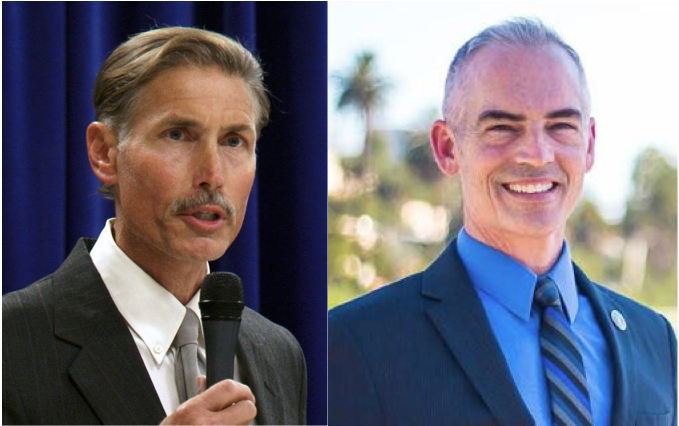Shredding CEQA: City Hall Still Not Listening
ENVIRONMENT POLITICS-Lately there's been a lot of talk about reforming the California Environmental Quality Act, also known as CEQA. A number of people, many of them developers and politicians, have been speaking out against CEQA, saying that it's basically a tool used by rabid NIMBYs to stifle development. On the other side there are community groups who see the law as their only protection against projects that destroy their neighborhoods.
But before I go on, let's do a little review. CEQA was enacted by the California state legislature in 1970. This landmark law was the result of a growing awareness that we had been way too reckless in the way we treated the environment. Across the U.S., cities were choking on toxic air and there were a number of horror stories about polluted water. The Federal government enacted the National Environmental Policy Act in 1969, and the following year California went even further by adopting CEQA. This was not the result of a coup backed by a few whiny tree-huggers. There was broad support from citizens concerned about levels of air and water pollution. A nasty oil spill in Santa Barbara in 1969, which dumped 200,000 gallons of crude into the ocean, helped make the case for immediate action.
That was over 40 years ago. These days it seems like the folks at City Hall and the Department of City Planning (DCP) consider CEQA nothing more than a useless impediment. But they aren't going to wait around for someone to try and reform the law. They've decided it's easier to just ignore it.
You think I'm kidding? The environmental review process in LA has become a joke. The DCP thinks nothing of adopting incomplete and inaccurate environmental documents. Citizens show up at hearings to point out the numerous problems with these assessments. City officials listen politely and then go ahead and approve the project. They know the only way anybody can stop them is by filing a lawsuit, and there are very few people who have the resources to do that. So the City routinely flouts the law, knowing that they have a damn good chance of getting away with it.
Let me give you a few examples...
One of the most mind-boggling experiences I've had in recent years was the City Planning Commission (CPC) hearing on the proposed Tommie Hotel at 6516 Selma in Hollywood (ENV-2016-4313-MND). This project should have warranted a full Environmental Impact Report (EIR), but the DCP chose to do a less rigorous Mitigated Negative Declaration (MND). The developer wants to build an 8-story hotel that includes bar/lounges on the ground floor and the rooftop, while also offering live entertainment. During the hearing the project reps talked about how this would be a great addition to Hollywood nightlife, but I kept wondering why the MND didn't mention Selma Avenue Elementary School in the section titled Surrounding Land Uses. The authors list the Capitol Records building and the Palladium, both about half a mile away, but neglect to mention an elementary school that's less than 500 feet away.
I was wondering if the Commissioners knew about the school, so I made sure to bring it up during public comment. Didn't even faze them. The prospect of building a party hotel offering liquor and live entertainment less than 500 feet from an elementary school apparently doesn't worry them at all. They did not mention the school once during the entire hearing.
This kind of thing isn’t unusual. Environmental assessments approved by the City routinely downplay or exclude information that might cause problems for the developer. Just take a look at the MND for the Ivar Gardens project (ENV-2015-2895-MND), a 21-story hotel to be built at Sunset and Cahuenga. This is one of the most congested areas in Hollywood, and driving through it during evening rush hour can be a grueling ordeal. But you’d never know that looking at the MND. The consultants who did the traffic assessment studied six intersections, and found that all but one operates at Level of Service A during PM rush hour, which means that traffic is flowing freely.
But anyone who’s travelled through this neighborhood after working hours knows that traffic northbound on Cahuenga and eastbound on Sunset often slows to a crawl. A number of people who spoke at the CPC hearing on the project pointed out how bad congestion already was in the area, and said a 21-story hotel would make things even worse. Did that stop the Commissioners from adopting the MND? Of course not. After some squabbling over community benefits, they voted to give it the green light.
The Mayor and the City Council do a lot of grandstanding about the environment, and to listen to them talk you’d think they were making LA the cleanest, greenest city on the planet. But their actions tell a different story. Greenhouse gas emissions (GHGs) are a huge concern these days, since the vast majority of climate scientists agree that they cause global warming. CEQA requires an assessment of a proposed project’s GHG impacts, but the documents approved by the City often play fast and loose with the numbers. In assessing CO2 emissions for Ivar Gardens, the MND says the “project net total” will be 1,921 metric tons per year (MTY). But if you look at the numbers carefully, you’ll see that the real total is 3,102 MTY. The first number actually represents the INCREASE in CO2 emissions caused by the project.
The scary thing is, this isn't the exception, it's the norm. At a time when we should be doing everything we can to stave off global warming, the DCP routinely approves environmental assessments that play games with the numbers to downplay GHG emissions. Take a look at the Draft EIR for the Wyvernwood redevelopment project (ENV-2008-2141-EIR), which would have tripled the size of an existing multi-family complex. Most developments these days incorporate some measures to reduce GHG emissions, and the law allows developers to make a case for their project based on what reductions they'll achieve compared to standard development practices, or a "business-as-usual" project. In the Wyvernwood EIR, the authors argued that the project would produce 30% to 31% less GHG emissions than a business-as-usual project. They come to the conclusion that, "...the project would not have a significant impact on the environment due to its GHG emissions."
What the authors don't mention is that the new development would actually MORE THAN DOUBLE the GHGs produced by the existing multi-family complex. There's no question that the proposed redevelopment of the site would have a significant impact on the environment. But the City doesn't challenge these bogus assessments, and in fact, the DCP does everything it can to push them through as quickly as possible.
A number of Boyle Heights community groups were staunchly opposed to the project, citing issues including displacement, loss of open space and historic preservation. After years of protests, Councilmember Jose Huizar finally listened to the community and announced that he opposed the project, which seems to have scuttled it. Still, there are those in Boyle Heights who fear it could be revived.
But to my mind, the most outrageous example of City Hall's absolute contempt for CEQA is the EIR for the Southern California International Gateway. The proposed SCIG involved the construction of a huge new rail facility for handling containerized cargo from the Port of Los Angeles.
From the outset, it was clear to the surrounding communities that the project would have severe negative impacts on air quality. Citizens groups protested that the SCIG would be detrimental to the health of nearby residential communities, which included schools and a veterans housing facility. In fact, the project was so toxic that the opposition grew to include the City of Long Beach, the South Coast Air Quality Management District (SCAQMD) and the Natural Resources Defense Council (NRDC).
Apparently unconcerned about the possibility of long-term health impacts to surrounding communities, the LA City Council approved the SCIG. Numerous plaintiffs took the City to court and, no surprise, they won. The judge who heard the case found that the EIR failed to address the project's impacts, not only in terms of air quality, but also in its analysis of noise and traffic. So we have to ask, why did City Hall ignore the pleas of so many people who obviously knew what they were talking about? Why did City Hall turn a deaf ear to the City of Long Beach, the SCAQMD and the NRDC? And ultimately, why does City Hall care so little about the health and safety of the people of Los Angeles?
You may view CEQA as a law crafted to protect the environment that all of us live in. That's not how City Hall sees it. In their view it's nothing more than a roadblock. And how do they deal with it? They step on the accelerator, bust right through, and keep on driving as if nothing happened.
(Casey Maddren is a native Angeleno, and currently serves as president of United Neighborhoods for Los Angeles (www.un4la.com). He also blogs about the city at The Horizon and the Skyline.) Edited for CityWatch by Linda Abrams.



 Notably, over fifty-six years earlier, Dr. Martin Luther King, Jr., preached a similar message of unity and inclusion at Woodland Hills Community Church (photo left). Invited to Southern California by a persistent white pastor named Fred Doty who revered King and wouldn’t let the extremely busy and over-extended civil rights leader refuse, King addressed the congregation on his birthday, on January 15, 1961, saying: “Love your neighbor as you love yourself … You are commanded to do that. That is the breadth of life.”
Notably, over fifty-six years earlier, Dr. Martin Luther King, Jr., preached a similar message of unity and inclusion at Woodland Hills Community Church (photo left). Invited to Southern California by a persistent white pastor named Fred Doty who revered King and wouldn’t let the extremely busy and over-extended civil rights leader refuse, King addressed the congregation on his birthday, on January 15, 1961, saying: “Love your neighbor as you love yourself … You are commanded to do that. That is the breadth of life.” 
 They are the geeks who are responsible for the monumental error at the 89th Academy Awards Sunday night when Hollywood legends Faye Dunaway and Warren Beatty mistakenly announced the Oscar for best film had been won by fan favorite “La La Land,” instead of low-budget outlier “Moonlight.”
They are the geeks who are responsible for the monumental error at the 89th Academy Awards Sunday night when Hollywood legends Faye Dunaway and Warren Beatty mistakenly announced the Oscar for best film had been won by fan favorite “La La Land,” instead of low-budget outlier “Moonlight.” The fancy bean-counters behind the incredible goof include Brian Cullinan, a PricewaterhouseCoopers partner who possibly has been doing this Oscars job too long. His biography on the PricewaterhouseCoopers website describes him as a Matt Damon lookalike. Seriously? In his dreams, is this Cornell Ivy Leaguer a Jason Borne wannabe as well?
The fancy bean-counters behind the incredible goof include Brian Cullinan, a PricewaterhouseCoopers partner who possibly has been doing this Oscars job too long. His biography on the PricewaterhouseCoopers website describes him as a Matt Damon lookalike. Seriously? In his dreams, is this Cornell Ivy Leaguer a Jason Borne wannabe as well?
 At the show, I met
At the show, I met 



 So remember Joe Sanchez’s words, and enter Adrienne Nicole Edwards (photo left), 28, a community advocate and business owner -- and an African American mom who today can boast what no other candidates in the race can.
So remember Joe Sanchez’s words, and enter Adrienne Nicole Edwards (photo left), 28, a community advocate and business owner -- and an African American mom who today can boast what no other candidates in the race can.
 I’m sure for some in the audience it wasn’t my anti-charter message that got them riled up. Some were rightly suspicious of a white Westsider telling them anything about educating urban, black youth. Heck, my own school board member’s chief-of-staff told me not to go to school board meetings, and to find a Latina instead, because it made things awkward for him in our primarily Latino district.
I’m sure for some in the audience it wasn’t my anti-charter message that got them riled up. Some were rightly suspicious of a white Westsider telling them anything about educating urban, black youth. Heck, my own school board member’s chief-of-staff told me not to go to school board meetings, and to find a Latina instead, because it made things awkward for him in our primarily Latino district. 
 Who are these four candidates? Unless you’ve been living under a rock, you know that the incumbent is Gil Cedillo. You may even remember his epic knock-down-drag-out battle with Ed Reyes’ Chief Deputy, Jose Gardea, over replacing the termed out Reyes. A couple of million bucks and a runoff later, Gil won.
Who are these four candidates? Unless you’ve been living under a rock, you know that the incumbent is Gil Cedillo. You may even remember his epic knock-down-drag-out battle with Ed Reyes’ Chief Deputy, Jose Gardea, over replacing the termed out Reyes. A couple of million bucks and a runoff later, Gil won. 







 Fortunately, Rising, 75, has some reassuring answers about today’s California, as I learned during two recent long conversations. And if you’re a reader who doesn’t know the name Nelson Rising, don’t worry—that’s the point. Nelson Rising’s story is about all the big things you can get done in California if you’re willing to listen more than you talk. Over the years his impressive accomplishments have spoken for themselves, without much ballyhoo for the man himself.
Fortunately, Rising, 75, has some reassuring answers about today’s California, as I learned during two recent long conversations. And if you’re a reader who doesn’t know the name Nelson Rising, don’t worry—that’s the point. Nelson Rising’s story is about all the big things you can get done in California if you’re willing to listen more than you talk. Over the years his impressive accomplishments have spoken for themselves, without much ballyhoo for the man himself.

 They project that LA County could suffer a potential three-year loss of 800,000 international visitors as a direct result of President Trump’s Executive Orders. These visitors typically spend $920 each while in LA, totaling a potential loss of $736 million in direct tourism spending.
They project that LA County could suffer a potential three-year loss of 800,000 international visitors as a direct result of President Trump’s Executive Orders. These visitors typically spend $920 each while in LA, totaling a potential loss of $736 million in direct tourism spending. 












